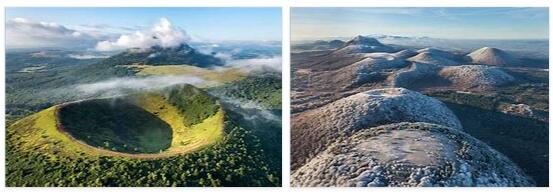
Anyone traveling in the Auvergne in central France will find it difficult to pass the Chaine des Puys volcanic chain. In the huge landscape of around 80 extinct volcanoes, which stretch over 40 kilometers, hikers, adventurers and hobby scientists get their money’s worth. The volcanoes offer a fascinating panorama. The oldest of these volcanic formations of the Chaine des Puys, which has been a UNESCO World Heritage Site since the beginning of July 2018, are around 100,000 years old. There are also numerous small lakes between the volcanic craters. In the region in the middle of the French Massif Central, not only do the best cyclists in the world take part in the Tour de France every year, it is also a popular destination for thousands of tourists from all over the world.
Vulcania: European Park for Volcanism in Saint-Ours
The most famous and largest volcano is the 1,465 meter high Puy de Dôme. Chaine des Puys is part of the Parc des Volcans d’Auvergne, the largest regional nature park in Europe. If you also want to learn something about the development of the earth’s history and the formation of the volcanic region, you should not miss a visit to the theme parks Volcan de Lemptégy or Vulcania in the municipality of Saint-Ours. The latter was opened in 2002 as the European Volcanism Park.
Montorgueil
Paris has countless sights for both locals and tourists. If you are visiting the French capital and just want to enjoy the very special flair of the city away from the tourist hotspots, you should definitely take the time for a walk in the pedestrian zone Rue Montorgueil in the traditional Sentier district. In the street, which is one of the busiest in all of Paris, you will find many small shops, bars, restaurants and numerous accommodations, such as the hotel “The Hoxton” from the 18th century. Rue Montorgueil is also known for its many stalls with fresh fruit and vegetables and the numerous florists. The “La Maison Stohrer” bakery from 1730 is also an important stop for tourists. It is one of the oldest bakeries in the French capital. At the end of the street is the Forum des Halles, one of the largest and most modern shopping and cultural centers in the city. The predominantly underground area has been extensively rebuilt and modernized since 2010. There are now 150 different shops on an area of almost 50,000 square meters. The city conservatory can also be found in the premises of the Forum des Halles. Another attraction on the street is the extremely imposing Saint-Eustache Church, built in the 15th and 16th centuries.
Plougrescant
Plougrescant – a surprise behind every bay
The commune of Plougrescant is located in the Côtes-d’Armor department in Brittany in north-western France. Plougrescant with its approximately 1220 inhabitants is located on a peninsula at the northernmost point of Brittany and enchants holidaymakers with contrasting facets that are confusing, fascinating and extraordinary.
Extremely charming little harbors, such as the oyster farm La Roche Jaune, or Port-Blanc, the latter with rocks painted white to help sailors navigate safely into port, take advantage of the sheltered corners of this coast.
Attractions
On the extreme northern tip of the peninsula, known either as Castel Meur or as Pointe du Château, one of the most picturesque houses in Brittany stands between two enormous boulders. The building is called La Maison du Gouffre, which means “the Schlund House” in German. The small house, which was built between two huge, jagged rocks directly on the coast, is world-famous and gives the impression of being wedged between the boulders. Castel Meur was built over 150 years ago and is one of the most popular photo opportunities in Brittany.
In the village of Plougrescant, interested visitors should definitely visit the church of Chapelle Saint-Gonéry. At first glance, the Chapel of Plougrescant looks as if it had emerged from the pages of a book of fairy tales. The wonderfully quirky medieval chapel looks like a cartoon building, crooked but delightful. Inside, the 15th century wall paintings are also cartoon-like. But the biblical stories are told here with such charming details and presented in front of such beautiful patterned backdrops that they are truly unforgettable.
Activities
The GR34 long-distance hiking trail leads hikers through the area and meanders along the coast along the main attractions. The best time to go hiking is at the end of April or in May.
Bayeux
Bayeux is a commune in the Calvados department in Normandy in north-western France. The city with about 13,600 inhabitants is located 7 kilometers from the coast of the English Channel and 30 kilometers northwest of Caen. The city, which is divided by the picturesque Aure River, is the capital of the Bessin, which extends northwest of Calvados.
Bayeux is a major tourist attraction best known to British and French visitors for the Bayeux tapestries, which commemorate the events of the Norman conquest of England in 1066. According to legend, the tapestry was made by Reine Mathilde, wife of William the Conqueror. The tapestries are exhibited in a museum in the city center.
Bayeux was extremely fortunate to avoid most of the post D-Day destruction and tragedy suffered by other cities in Normandy. For a brief moment, Bayeux was the capital of Free France and General Charles de Gaulle gave two famous speeches in this city. Bayeux has its own extensive War Museum and British and Commonwealth War Cemetery, while D-Day Beaches and many other related museums and World War II monuments are close by. There are also some beautiful beaches and the lively fishing port of Port-en-Bessin. There are also great castles and abbeys in the nearby countryside.